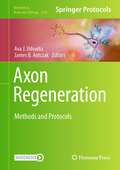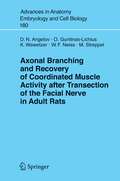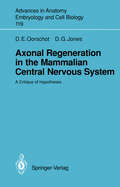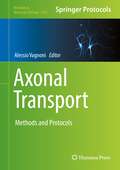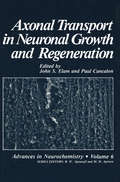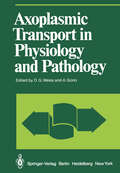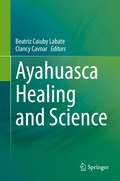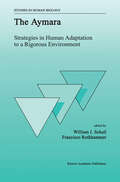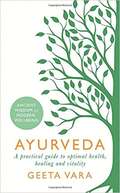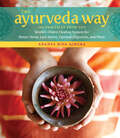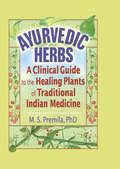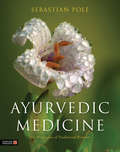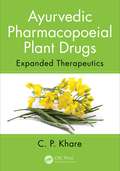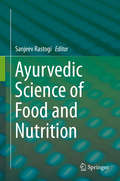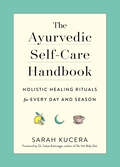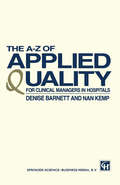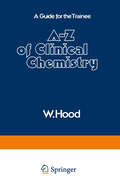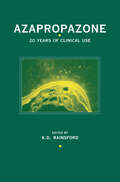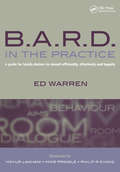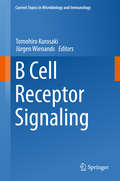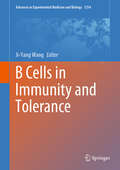- Table View
- List View
Axon Regeneration: Methods and Protocols (Methods in Molecular Biology #2636)
by Ava J. Udvadia James B. AntczakThis volume covers a wide range of approaches utilized to decipher cellular and molecular mechanisms that contribute to successful nerve regeneration leading to functional recovery. Chapters detail a variety of models utilizing both in vivo and in vitro approaches, physical injury models, methods for the isolation/analysis of various macromolecules, live and fixed imaging of regenerating axons, and for quantifying behavioral endpoints enable measurements of regenerative success. Written in the format of the highly successful Methods in Molecular Biology series, each chapter includes an introduction to the topic, lists necessary materials and methods, includes tips on troubleshooting and known pitfalls, and step-by-step, readily reproducible protocols. Authoritative and cutting-edge, Axon Regeneration: Methods and Protocols aims to be comprehensive guide for researchers.
Axonal Branching and Recovery of Coordinated Muscle Activity after Transsection of the Facial Nerve in Adult Rats (Advances in Anatomy, Embryology and Cell Biology #180)
by Doychin N. Angelov Orlando Guntinas-Lichius Konstantin Wewetzer Wolfram Neiss Michael StreppelFacial nerve surgery inevitably leads to partial pareses, abnormally associated movements and pathologically altered reflexes. The reason for this "post-paralytic syndrome" is the misdirected reinnervation of targets, which consists of two major components. First, due to malfunctioning axonal guidance, a muscle gets reinnervated by a "foreign" axon, that has been misrouted along a "wrong" fascicle. Second, the supernumerary collateral branches emerging from all transected axons simultaneously innervate antagonistic muscles and cause severe impairment of their coordinated activity. Since it is hardly possible to influence the first major component and improve the guidance of several thousands axons, the authors concentrated on the second major component and tried to reduce the collateral axonal branching.
Axonal Regeneration in the Mammalian Central Nervous System: A Critique of Hypotheses (Advances in Anatomy, Embryology and Cell Biology #119)
by Dorothy E. Oorschot David G. JonesThis state-of-the-art review links the experimental data into a cohesive and critical account of CNS regeneration. Research findings are discussed in terms of their relevance to one (or more) of thirteen hypotheses concerned with regeneration in the mammalian CNS. Research findings reviewed include: regeneration in developing mammals and in submammalian vertebrates, the use of transplants and/or pharmacological treatments, in vitro studies on neurotrophic and neurite promoting factors and their potential relevance to CNS regeneration in vivo, and in vitro studies on the types of glial cells that may be responsible for enhancing or suppressing axonal re-growth.
Axonal Transport: Methods and Protocols (Methods in Molecular Biology #2431)
by Alessio VagnoniThis volume covers a wide range of model systems from invertebrate to humans and in vitro and in vivo. Chapters detail methods on squid, aplysia, xenopus, mouse in vivo, ex vivo, rodent primary neurons, human-derived neurons, zebrafish, drosophila in vivo, primary neurons, c. elegans, and in vitro reconstitution assays.Written in the format of the highly successful Methods in Molecular Biology series, each chapter includes an introduction to the topic, lists necessary materials and reagents, includes tips on troubleshooting and known pitfalls, and step-by-step, readily reproducible protocols. Authoritative and cutting-edge, Axonal Transport: Methods and Protocols aims to further our understanding of the trafficking of cellular components in the nervous system leading to the advancement of basic knowledge that underlines the cell biology of the neuron.The chapters “ Live imaging of RNA Transport and Translation in Xenopus Retinal Axons, Retrograde Axonal Transport of Neurotrophins in Basal Forebrain Cholinergic Neurons, Assessment of Mitochondrial Trafficking as A Surrogate of Fast Axonal Transport in Human Induced Pluripotent Stem Cell Derived Spinal Motor Neurons, Drosophila Primary Neuronal Cultures as a Useful Cellular Model to Study and Image Axonal Transport, and In vitro Reconstitution of Kinesin-Based, Axonal mRNA Transport” are available open access under a Creative Commons Attribution 4.0 International License via link.springer.com
Axonal Transport in Neuronal Growth and Regeneration (Advances in Neurochemistry #22)
by John ElamOver the past several years, the pace of research on the control of axonal growth has increased at a remarkable rate, and this activity is reflected in a growing literature dealing with various aspects of axonal growth and regener ation. It appears timely to review the role played by axonal transport in the intrinsic responses of neurons in the growth and regrowth processes. Through the cooperation of the senior editors of this series, we have been given the opportunity to bring such a focus to the current volume. We wish to acknowledge that the contributing authors attended a confer ence on "The Role of Axonal Transport in Neuronal Growth and Regenera tion" held in Tallahassee, Florida in March, 1983, sponsored by the Psycho biology Research Center of the Florida State University. It is our hope that many of the perceptions and insights expressed in these chapters resulted from our interactions.
Axoplasmic Transport in Physiology and Pathology (Proceedings in Life Sciences)
by D. G. Weiss A. GorioCajal and contemporary scientists have laid the basis of the modem concepts of the organization of the nervous system: the cir cuits of the brain are made up of individual neurons which transfer information via specialized structures called synapses. Soma and den drites usually receive the inputs, then the signal is carried all along the axon to the target areas. To fulfIll this task several types of neurons have developed their unique geometry characterized by a large recep tive area (soma and dendrites) and an often very extensive distal branching with the axon terminals. The volume of cytoplasm which constitutes the neuronal periphery is often far larger than the cell body, where the synthetic machinery is located. It is one of the roles ofaxoplasmic transport to supply the periphery with proper material and to sustain the specialized structures necessary for the physiological activity of the neuron. Furthermore, it has become more and more clear that target areas also exert effects on the innervating neurons, and these effects are not only mediated via recurrent fibers. Synapses have been shown to be able to pick up material from the synaptic left which is then intra axon ally transported back to the cell body. This retrograde axoplasmic transport has therefore been recognized as another basic mechanism to convey signals from the periphery to the centre.
Ayahuasca Healing and Science
by Beatriz Caiuby Labate Clancy CavnarThis book offers a series of perspectives on the therapeutic potential of the ritual and clinical use of the Amazonian hallucinogenic brew ayahuasca in the treatment and management of various disorders. This book presents biomedical and anthropological data on the use of ayahuasca and provides critiques on how it is used for treating depression, PTSD, anxiety, substance dependence, and eating disorders. The volume also explores ayahuasca’s role in the psychological well-being and quality of life of humans, and discusses possibilities of it enhancing cognition and coping with grief. The book examines ayahuasca’s association with psychotherapy and also highlights the challenges of integrating plant medicines into psychiatry. Further, the book expands on some preliminary research with animals, suggesting that ayahuasca acts at multiple levels of neural complexity. The study on the neurogenic effects of ayahuasca alkaloids opens a new avenue of research with potential applications ranging from psychiatric disorders to brain damage and dementia. Psychologists, psychiatrists, and other mental health professionals will find this book relevant to their work regarding substance abuse and alternative medicine.
The Aymara: Strategies in Human Adaptation to a Rigorous Environment (Studies in Human Biology #2)
by W. J. Schull F. RothhammerSouth America's Andean highlands have seen the rise and decline of several impressive, indigenous civilizations. Separated somewhat in time and place, each developed its distinctive socio-cultural accouterments but all shared a need to adjust to the individual, societal and environmental limitations imposed by life at high altitude. Partial oxygen pressure, temperature and humidity fall systematically as altitude rises, but there are other changes as well. Darwin, Forbes, von Humboldt, von Tschudi and other naturalists of the eighteenth and nineteenth centuries who weaved their way through South America commented repeatedly on the tolerance or apparent indifference of the indigenes to the rigors of life at altitudes above 3000 meters but its impact upon lowlanders. Von Tschudi (1847), for example, observed 'in the cordillera the effect of the diminished atmospheric pressure on the human frame shows itself in intolerable symptoms of weariness and an extreme difficulty of breathing . . . . The first symptoms are usually felt at the elevation of 12,600 feet (3800 m) above the sea. These symptoms are vertigo, dimness of sight and hearing, pains in the head and nausea . . . . Inhabitants of the coast and Europeans, who for the first time visit the lofty regions of the cordillera, are usually attacked with this disorder. ' But von Tschudi's description of acute mountain sickness was hardly the first; his Spanish predecessors had known and commented upon it too.
Ay's Neuroanatomy of C. Elegans for Computation (Routledge Revivals)
by Theodore B. Achacoso William S. YamamotoFirst published in 1992, AY's Neuroanatomy of C. elegans for Computation provides the neural circuitry database of the nematode Caenorhabditis elegans, both in printed form and in ASCII files on 5.25-inch diskettes (for use on IBM® and compatible personal computers, Macintosh® computers, and higher level machines). Tables of connections among neuron classes, synapses among individual neurons, gap junctions among neurons, worm cells and their embryonic origin, and synthetically derived neuromuscular connections are presented together with the references from which the data were compiled and edited. Sample data files and source codes of FORTRAN and BASIC programs are provided to illustrate the use of mathematical tools for any researcher or student interested in examining a natural neural network and discovering what makes it tick.
Ay's Neuroanatomy of C. Elegans for Computation (Routledge Revivals)
by Theodore B. Achacoso William S. YamamotoFirst published in 1992, AY's Neuroanatomy of C. elegans for Computation provides the neural circuitry database of the nematode Caenorhabditis elegans, both in printed form and in ASCII files on 5.25-inch diskettes (for use on IBM® and compatible personal computers, Macintosh® computers, and higher level machines). Tables of connections among neuron classes, synapses among individual neurons, gap junctions among neurons, worm cells and their embryonic origin, and synthetically derived neuromuscular connections are presented together with the references from which the data were compiled and edited. Sample data files and source codes of FORTRAN and BASIC programs are provided to illustrate the use of mathematical tools for any researcher or student interested in examining a natural neural network and discovering what makes it tick.
Ayurveda: Ancient wisdom for modern wellbeing
by Geeta Vara'An excellent masterpiece that brings the ancient timeless wisdom of Ayurveda, in a very simple and practical way, to our modern day-to-day life' - Dr Vasant Lad, Director of The Ayurvedic InstituteAyurveda is a 5000-year-old system of medicine that takes a much needed holistic approach to life and wellbeing. Through balancing the three energy forces in the body known as 'doshas', Ayurveda goes beyond the boundaries of conventional practice to reveal your unique physical, emotional and mental needs.Expert practitioner Geeta Vara BSc and PGDip in Ayurvedic Medicine, gives simple, daily applicable rituals and wisdom that can be personalised to suit you, including guidance on food as medicine, detoxification, movement and meditation.By teaching us to reconnect with our natural bio-circadian rhythms, Ayurveda will lead you out of the doctor's surgery and on a journey towards self-healing.WITH THIS BOOK, YOU CAN: · Discover your mind/body type · Better understand the epicentre of your health - the gut · Learn to identify early signs of imbalance · Transform your diet through taste and mindful eating · Be empowered to take a preventative approach to healthcare · Tackle personal health problems including: stress and fatigue, immune system issues, gastro-intestinal problems, disturbed sleep, migraines, weight management and more
The Ayurveda Way: 108 Practices from the World's Oldest Healing System for Better Sleep, Less Stress, Optimal Digestion, and More
by Ananta Ripa AjmeraCelebrated Ayurveda teacher Ananta Ripa Ajmera offers an inspiring introduction to this ancient Indian medical tradition, which complements and extends the health and wellness benefits of yoga. Through 108 short essays you will learn to approach optimal digestion, better sleep, less stress, and a more balanced life. Diet is key, and many essays are accompanied by recipes that incorporate into daily meals spices such as turmeric, cumin, ginger, and mustard seeds. In addition, meditation, yoga and breathing exercises, and self-care practices such as oil pulling and massage, make this time-tested wisdom available to contemporary holistic health enthusiasts — even beginners.
Ayurvedic Herbs: A Clinical Guide to the Healing Plants of Traditional Indian Medicine
by Virginia M Tyler M.S. PremilaA single-source reference on the most important and best-investigated Ayurvedic herbs This book examines the clinical information available on more than 60 Ayurvedic herbs to determine how their use in traditional Indian medicine is supported by modern scientific study. Plants are grouped according to body systems and each entry includes a description, information on the source plant, distribution and traditional use, active chemical constituents, relevant pharmacology, and details of clinical studies and safety findings. This unique book also includes a brief history of Ayurveda, examines the history of drug development and evaluation in ancient India, and identifies current trends resulting from scientific investigation. Worldwide interest in Ayurveda is growing quickly, especially in the United States, Europe, and Japan. But until now, information on Western-style clinical trials on Ayurveda herbs has been scattered and no single source for descriptions, comments, and references has existed. Ayurvedic Herbs presents the first critical validation of Ayurvedic medicine, extensively referenced for physicians and clinicians interested in alternative and adjunctive therapies. This unique book is essential for making informed choices on herb use, offering clinical trial data, results of pharmacological studies, and safety information.Ayurvedic Herbs examines: gastrointestinal agents hepatoprotective agents respiratory tract agents cardiovascular drugs urinary tract drugs antirheumatic agents skin and trauma care agents gynecological agents antidiabetic agents CNS agents rasayana drugs dental and ophthamological agents and much moreAyurvedic Herbs includes cross-references to chapters when a particular plant has more than one indication and watercolor illustrations of twelve major herbs.
Ayurvedic Herbs: A Clinical Guide to the Healing Plants of Traditional Indian Medicine
by Virginia M Tyler M.S. PremilaA single-source reference on the most important and best-investigated Ayurvedic herbs This book examines the clinical information available on more than 60 Ayurvedic herbs to determine how their use in traditional Indian medicine is supported by modern scientific study. Plants are grouped according to body systems and each entry includes a description, information on the source plant, distribution and traditional use, active chemical constituents, relevant pharmacology, and details of clinical studies and safety findings. This unique book also includes a brief history of Ayurveda, examines the history of drug development and evaluation in ancient India, and identifies current trends resulting from scientific investigation. Worldwide interest in Ayurveda is growing quickly, especially in the United States, Europe, and Japan. But until now, information on Western-style clinical trials on Ayurveda herbs has been scattered and no single source for descriptions, comments, and references has existed. Ayurvedic Herbs presents the first critical validation of Ayurvedic medicine, extensively referenced for physicians and clinicians interested in alternative and adjunctive therapies. This unique book is essential for making informed choices on herb use, offering clinical trial data, results of pharmacological studies, and safety information.Ayurvedic Herbs examines: gastrointestinal agents hepatoprotective agents respiratory tract agents cardiovascular drugs urinary tract drugs antirheumatic agents skin and trauma care agents gynecological agents antidiabetic agents CNS agents rasayana drugs dental and ophthamological agents and much moreAyurvedic Herbs includes cross-references to chapters when a particular plant has more than one indication and watercolor illustrations of twelve major herbs.
Ayurvedic Medicine: The Principles of Traditional Practice (PDF)
by Sebastian PoleAyurvedic Medicine clearly and comprehensively presents the unique theories and traditions of Ayurveda making them accessible to the health practitioner of today. With a brief history of traditional medicine in India and discussion of principles, treatment strategies and traditional Ayurvedic pharmacy and pharmacology, the book offers an essential overview of the culture in which Ayurveda has developed and the scientific basis behind this holistic approach. It details over 100 plant profiles of Ayurvedic herbs, with images of fresh and dried plants, and 50 traditional formulas, including characteristics, usage, combinations, contraindications, and safety and dosage information for each. This essential resource explains the traditional medical system of Ayurveda, and provides guidance to students and practitioners on how to incorporate herbal medicine into their life and practice.
Ayurvedic Pharmacopoeial Plant Drugs: Expanded Therapeutics
by C. P. Khare"This kind of systematic work is exactly what is needed for people to help bridge traditional Ayurvedic practice with modern science."�Venkatraman Ramakrishnan, Nobel laureate, current president of the Royal Society and group leader at the Medical Research Council Laboratory of Molecular Biology, Cambridge Biomedical Campus, UKAyurvedic Pharmacopoe
Ayurvedic Science of Food and Nutrition
by Sanjeev RastogiAyurveda is widely considered to be one of the oldest health care traditions still in practice today. Originating in India over 3,000 years ago, it is now increasingly recognized and practiced globally including in many European countries and the United States.Food and nutrition play a crucial role in the health care wisdom of Ayurveda. The Ayurvedic Science of Food and Nutrition discusses the various principles of healthy eating as prescribed by Ayurveda. Divided into three sections, it addresses the fundamentals, the clinical applications, and the future challenges of Ayurveda. Specifically, the book discusses issues such as the concept of diet, the use of food as medicine, especially to treat diabetes and cancer, convalescent food practices, and fasting therapy. The Ayurvedic Science of Food and Nutrition is unique in that it is one of the only books to investigate the scientific rationale behind Ayurveda, enabling this health care tradition to potentially be incorporated into a Western clinical practice model when this latter conventional therapy is found to be ineffective.
The Ayurvedic Self-Care Handbook: Holistic Healing Rituals for Every Day and Season
by Sarah KuceraAncient self-care for modern life, by the author of the forthcoming The Seven Ways of Ayurveda Feeling burned-out, unmotivated, or stuck? The Ayurvedic Self-Care Handbook is here to help. This authoritative guide to ancient healing offers more than 100 daily and seasonal Ayurvedic rituals—each taking 10 minutes or less—to reconnect you with nature&’s rhythms, and to unlock better health, as you: Boost and stabilize your energy with yogic breathingOvercome transitions with grounding meditationsUndo physical and emotional stress with personalized yoga posturesPrevent and treat disease with nourishing tonics and teasPause and reflect with daily and weekly journaling prompts. Get back in sync with nature—and rediscover your potential to feel good.
A–Z of Clinical Chemistry: A Guide for the Trainee
by W. HoodThe newcomer to the field of clinical chemistry is faced with the daunting prospect of understanding the ever increasing aspects of the subject: new techniques, tests, terminology, methods of diagnosing diseases and other advances which relate to clinical chemistry. The aim of this book is to provide basic information regarding all branches of the subject which the trainee will need to understand. The book should also provide a basis for answering many of the examination questions of clinical chemistry. It is therefore hoped that this book will prove useful to any person starting a career in clinical chemistry, be that person a laboratory scientific officer, graduate or trainee pathologist. Wherever possible, suggestions for further reading are given. Many subjects are so broad however that the reader is referred to the general list of analytical and clinical textbooks supplied at the end of the book. My grateful thanks are extended to the three ladies who typed this manuscript: Christine Cliffe, Margaret Donnelly and Judith Hardy. I would like to thank Dr Brian Wisdom of Queens University, Belfast for his suggestions on the entry "Enzyme-immunoassay". Finally my thanks go to Mr Martin Lister of MTP Press for his help and encouragement in this venture. W. H. ASHTON-UNDER-L YNE APRIL 1980 vii A ABETALIPOPROTEINAEMIA A rare hereditary disorder in which there is a complete absence of j3-lipoprotein, pre:f3-1ipoprotein and chylomicrons. It presents clinically as ataxia and malabsorption with steatorrhoea. Thorny shaped erythrocytes (acanthocytes) are a feature of the disease.
B.A.R.D. in the Practice: A Guide for Family Doctors to Consult Efficiently, Effectively and Happily
by Ed WarrenForewords by Mayur Lakhani, Mike Pringle and Philip R Evans Respectively Chairman of Communications and Publishing, Royal College of General Practitioners, London; Head of School and Professor of General Practice, University of Nottingham; Former President of WONCA Region Europe. This groundbreaking book describes a completely new approach to the medical consultation, focusing on four key points: Behaviour, Aims, Room and Dialogue (B.A.R.D.). This practical approach has gained support from the Royal College of General Practitioners and reflects the way real family doctors consult in the real world, to the benefit of both the practitioner and the patient. Practical suggestions are made throughout the guide, with training exercises to aid in application. B.A.R.D in the Practice provides important reading for all general practitioners and general practitioner registrars.
B.A.R.D. in the Practice: A Guide for Family Doctors to Consult Efficiently, Effectively and Happily
by Ed WarrenForewords by Mayur Lakhani, Mike Pringle and Philip R Evans Respectively Chairman of Communications and Publishing, Royal College of General Practitioners, London; Head of School and Professor of General Practice, University of Nottingham; Former President of WONCA Region Europe. This groundbreaking book describes a completely new approach to the medical consultation, focusing on four key points: Behaviour, Aims, Room and Dialogue (B.A.R.D.). This practical approach has gained support from the Royal College of General Practitioners and reflects the way real family doctors consult in the real world, to the benefit of both the practitioner and the patient. Practical suggestions are made throughout the guide, with training exercises to aid in application. B.A.R.D in the Practice provides important reading for all general practitioners and general practitioner registrars.
B Cell Receptor Signaling (Current Topics in Microbiology and Immunology #393)
by Tomohiro Kurosaki Jürgen WienandsThis volume details our current understanding of the architecture and signaling capabilities of the B cell antigen receptor (BCR) in health and disease. The first chapters review new insights into the assembly of BCR components and their organization on the cell surface. Subsequent contributions focus on the molecular interactions that connect the BCR with major intracellular signaling pathways such as Ca2+ mobilization, membrane phospholipid metabolism, nuclear translocation of NF-kB or the activation of Bruton’s Tyrosine Kinase and MAP kinases. These elements orchestrate cytoplasmic and nuclear responses as well as cytoskeleton dynamics for antigen internalization. Furthermore, a key mechanism of how B cells remember their cognate antigen is discussed in detail. Altogether, the discoveries presented provide a better understanding of B cell biology and help to explain some B cell-mediated pathogenicities, like autoimmune phenomena or the formation of B cell tumors, while also paving the way for eventually combating these diseases.
B Cells in Immunity and Tolerance (Advances in Experimental Medicine and Biology #1254)
by Ji-Yang WangThis book contains twelve chapters contributed by prestigious international experts who are at the forefront of B cell research, and aims to provide a cutting-edge and comprehensive overview of all aspects of B cells, including B cell development, maturation and activation, germinal center reaction, memory and plasma cell differentiation, and antibody-mediated positive and negative regulation of humoral immune responses. There are also three chapters describing human diseases caused by B cell abnormalities, including primary antibody deficiencies, autoimmune diseases, and B cell malignancies. We hope that this book will become a standard and routine reference for both basic researchers and clinicians.
